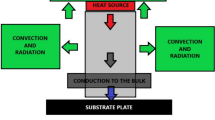Abstract
This study focuses on the Bubnov-Galerkin finite element model used to obtain the stresses and pressure fields set up at various cross-sections of a blank during the metal forming process. Four Lagrange quadratic elements were assembled to represent the various blanks. The governing equation adopted is a one-dimensional differential equation describing the pressures and stresses exerted on the forming process. In conducting the analysis, the various blanks are divided into a finite number of elements and further applying the Bubnov-Galerkin-weighted residual method to obtain the weighted integral form; the finite element model is obtained in a matrix form, from the weighted residual boundary conditions which are now applied to obtain the pressure distribution across the cross-section of the various blanks. Finite element results are obtained for a value of the coefficient of friction, die angle, length, and blank radius. Solution of the finite element method was compared with the exact solution, along with an experimental test known as press-fit analysis using Ansys Workbench, a program-controlled mesh of polar hexahedral elements which was utilized to further validate the result. Furthermore, the use of a computer-aided software assists in visualizing the solution of the tube sinking problem. The results were all presented in both tabular and graphical modes. This study shows that there are potentials for using this approach in engineering practices to ensure that the strength of materials be considered before usage in design and fabrication. These results are expected to improve advance knowledge in manufacturing processes.









Similar content being viewed by others
Data availability
Nil.
References
Zhang WJ, Lin Y, (2005). On the function-behavior-structure model for design. Canadian Design Engineering Network Conference 2005
Zhang WJ, Wang JW (2016) Design theory and methodology for enterprise systems. Enterp Inf Syst 10(3):245–248. https://doi.org/10.1080/17517575.2015.1080860
Bickford WB (1989) “A first course in the finite element method” Arizona state university, AZ (1989)
Burnet DS (1987) Finite element analysis, from concept to application. Addison Wesley, New Jersey
Cao L, Dolovich AT, Chen A, Zhang, W. (Chris). (2018) Topology optimization of efficient and strong hybrid compliant mechanisms using a mixed mesh of beams and flexure hinges with strength control. Mech Mach Theory 121(December 2017):213–227. https://doi.org/10.1016/j.mechmachtheory.2017.10.022
Hu X, Cao L, Luo Y, Chen A, Zhang E, Zhang WJ (2019) A novel methodology for comprehensive modeling of the kinetic behavior of steerable catheters. IEEE/ASME Transactions on Mechatronics 24(4):1785–1797. https://doi.org/10.1109/TMECH.2019.2928786
Zhang WJ, van der Werf K (1997) Automatic communication from a neutral object model of mechanisms to mechanism analysis program system based on a finite element approach. Finite Elem Anal Des 28(3):209–240
Reddy JN (2006) “An introduction to the finite element method”, 3rd Edition, McGraw Hill
Castro CF, António CAC, Sousa LC (2004) Optimization of shape and process parameters in metal forging using genetic algorithms. J Mater Process Technol 146(3):356–364
Cao L, Dolovich A, Zhang WJ (2013) On understanding of design problem formulation for compliant mechanisms through topology optimization. Mech Sci 4(2):357–369. https://doi.org/10.5194/ms-4-357-2013
Cao L, Dolovich AT, and Zhang WC (2015) Hybrid compliant mechanism design using a mixed mesh of flexure hinge elements and beam elements through topology optimization. J Mech Design, Transactions of the ASME, 137(9). https://doi.org/10.1115/1.4030990
Cao L, Dolovich AT, Schwab AL, Herder JL, Zhang WJ (2015) Towards a unified design approach for both compliant mechanisms and rigid-body mechanisms: module optimization. ASME J Mech Design 137(12):122301–122301-10. https://doi.org/10.1115/1.4031294
Kim YS, Son HS, Kim C II (2003) Rigid-plastic finite element simulation for process design of impeller hub forming. J Mater Process Technol 143-144(1):729–734
MacCormack C, Monaghan J (2001) Failure analysis of cold forging dies using FEA. J Mater Process Technol 117(1-2):209–219
Song JH, Im YT (2007) Process design for closed-die forging of bevel gear by finite element analyses. J Mater Process Technol 192–193(10):1–7
Hu C, Wang K, Liu Q (2007) Study on a new technological scheme for cold forging of spur gears. J Mater Process Technol 187-188(2007):600–603
Kim H, Taylan A (1996) Cold forging of steel — practical examples of computerized part and process design. J Mater Process Technol 59(1-2):122–131
Akpobi JA, Edobor CO (2009) Development of a model for analysis forging process. J Adv Mater Res 62-64:621–628
Erhunmwum I, Oladeinde M (2016) Analysis of flow in a concentric annulus using finite element method. Niger J Technol 35(2):344
Liu YF, Li J, Zhang ZM, Hu XH, Zhang WJ (2015) Experimental comparison of five friction models on the same test-bed of the micro stick-slip motion system. Mechanical Sciences 6(1):15–28. https://doi.org/10.5194/ms-6-15-2015
Author information
Authors and Affiliations
Contributions
Akinola Ogbeyemi: conceptualization, methodology, supervision, and writing (original draft). Ikechukwu Okoh: conceptualization, MATLAB data analysis, and writing (review and editing). Imuero Orogo: methodology and writing (review and editing). Osezua Ibhadode: results validation and review. John Akpobi: project administration and overall supervision.
Corresponding author
Ethics declarations
Ethical approval
This research does not involve human or animal participants.
Consent to participate
No participation is included in this research.
Consent to publish
The authors agree with the copyright transfer statement.
Competing interests
The authors declare no competing interests.
Additional information
Publisher’s note
Springer Nature remains neutral with regard to jurisdictional claims in published maps and institutional affiliations.
Rights and permissions
About this article
Cite this article
Ogbeyemi, A., Okoh, I., Imuero, O. et al. Load prediction on metal forming process (tube sinking) using finite element method. Int J Adv Manuf Technol 114, 2961–2973 (2021). https://doi.org/10.1007/s00170-021-06907-9
Received:
Accepted:
Published:
Issue Date:
DOI: https://doi.org/10.1007/s00170-021-06907-9




